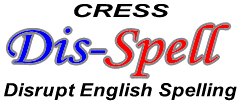CRESS Guide and HowTo
Page in Progress, Unfinished Version 0
CRESS is simple to learn and use.
Don’t be shocked or judge a book by its cover
It looks different from traditional spelling but is magically simple and related
Everything learned applies to standard English and provides a bridge to it
How
Just learn a few simple facts about pronunciation, e.g. how your tongue moves to make sounds
This guarantees full phonemic awareness, the holy grail of reading education
Use the regular alphabet but in a simple way that is easy to learn
Just write as you speak, one symbol for each sound… regularly and consistently
No exceptions to learn
The Alphabet
Use the same alphabet as standard English spelling, quickly readable without much learning
Most consonants require no learning:
p as pot
b as in bought
t as in taught
d as in daughter
k as in caught
g as in got
f as in fat
v as in vat
s as in sap
z as in zap
h as in hat
l as in lot
r as in rot
Vowels are extremely simple
Simply use just the 5 basic vowels to fix English spelling chaos
1. Just remember the BASIC PRONUNCIATIONS
2. i as in pit, e as in pet, u as in put, o as in pour, a as in pot
3. This is all that needs to be learned, the rest is simple logic
Big Tip:
Say the vowel letters with these individual sounds when reciting the alphabet
It’s good to say the phrases: i as in pit, e as in pet, u as in put, o as in pour, a as in pot
Just memorize these… there is NOTHING ELSE TO LEARN
A Simple Trick Simplifies Everything
Just use the same alphabet as standard English spelling
Just learn a few simple facts about pronunciation, e.g. how your tongue moves to make sounds
Just use 3 simple movement arrows < > ^ to show neighboring sound adjustments
The extra arrow symbols make perfect sense in terms of tongue position so require no learning
< = move the tongue frontward, > = move the tongue backward, ^ = move the tongue upward
These symbols are already on your keyboard
Imagine seeing the tongue in an x ray from the left side.
Students can easily sketch the tongue for themselves.
When you raise the tongue in vowels, just point up with the ^ arrow
For consonants and vowels use forward < and back arrow > to show tongue adjustments
Don’t worry, it’s worth it:
1. Reading and spelling become easy.
2. Words look similar to standard English spelling.
3. Computer translation (transliteration) exists, both to and from standard English spelling.
4. The length of text is shorter, with fewer keystrokes, and taking up less paper or screen space.
See for Yourself: CRESS is Very Simple
Just use the same alphabet as standard English spelling
Here are basic vowel adjustments:
i^ as in Pete not i as in pit
e^ as in bate not e as in bet
u^ as in boot not u as in put
o^ as in boat not o as in bore
a< as in bat not a as in pot
a^ as in but not a as in pot
You can hear and feel these yourself so no need to memorize
1. Say them super super slow stretching them out
2. Pay attention to how your tongue moves
3. Practice sliding your tongue back and forth with and without the arrow
Here are basic consonant adjustments:
t as in tin, t< as in thin
d as in dough, d< as in though
s as in sin, s< as in shin
z as in buzzer, z< as in measure
You can hear and feel these yourself so no need to memorize
1. Say them super super slow stretching them out
2. Pay attention to how your tongue moves
3. Practice sliding your tongue back and forth with and without the arrow
In a few cases, two sound symbols are joined because the pronunciation involves two distinct sounds:
ai as in bite
au as in bout
oi as boy
ts> as in chin not ts as in pits
dz> as twice in judge not dz as in ‘The lids in…”
You can hear and feel these yourself so no need to memorize
1. Say them super super slow stretching them out
2. Pay attention to the two parts that you pronounce separately
There’s an understanding that the symbols represent a general area of tongue placement without specifying fine detail
This is evident in a^r as in hurt where the tongue is a bit higher than in the a^ in but. It might even be written a^^ but this clutters the system.
Some letter combinations might be optional alternatives after basic phonetic learning
1. These could make CRESS look even more like traditional spelling
a. th, sh could be retained for s< and s> respectively
b. ch, j could be retained for ts> and dz> respectively
2. These would be less systematic, less phonemic, and less phonetically indicative but visually conservative
